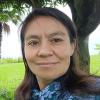This morning I look and enjoy the sunrise from the mountain … but also I can smell the smoke from the forest fire.
I am sitting next to Eleuterio, a man who knows the heart of the trees, a man who has heard in his 80 years the sound of the wind embracing the hills and reaching the sea.
Sitting under an almond tree, the tree of solidarity (as poet Gabriela Mistral called it), we silently observed the destruction left behind by the forest fires in Chile earlier this year, the largest in the country's history, according to the authorities. The fires left 11 dead — including two policemen and four firefighters — destroyed about 3,000 homes, and devastated about 400,000 hectares (more than 1,500 square miles).
In his heart Eleuterio sees the house of his parents, where he himself was born; the memories of his childhood playing in the middle of the forest and his youthful dreams of having a family and a simple wooden house. He remembers, too, his daily work in the forest, hoping it would allow the wood necessary to provide food and a dignified life for his children.
Today, all that has been destroyed. Although there is speculation about the causes of the fires, what touches my heart is what God has allowed me to share with people who were stripped of everything overnight: their homes, their clothes, their everyday lives — and even their dreams.
We were invited to share with them during a weekend in the region of El Maule, through a service of listening in the town of Santa Olga. We also visited people living in little villages in the woods.
I certainly did not do much, simply lent my heart and my ear to the cry of each person who, in the midst of tears, experienced a strong moment of unexpected and inexplicable mourning and loss. Their safe space, their home, their lands, had become a nightmare. Many families tried to save their homes by putting water in them, until the closeness of the fire and smoke drove them away.
Today, a month after the fires, the smoke is still perceptible in the air, and many people still sleep in tents. I see the pain in their eyes, I can feel the tears in their hearts for the suffering of this land and for the hopes that were lost.
In the midst of all this, two people gave me a sacrament of God’s presence.
Eleuterio, looking at the horizon and recalling stories of his life, told me about his knowledge of the trees, his relationship with them and how, in the silence of the forest, he can feel their pain and their joy.
Each tree has a history, he told me. It is the story of when it was planted and how it turned itself to the sun, growing and standing witness to each season — but also to the story of the families. And Eleuterio let me see with his wisdom that life begins to rise in the midst of the ashes.
Antonia, an elderly woman who cares for her son with special needs, is really grateful for the presence of the God who saved them. She shows this with a beautiful smile.
When I was leaving her home, which was nearly destroyed, she embraced me and gave me a little plant that was beginning to grow again. I received it as a sacrament of life. Even in the midst of the damage, Antonia catches her breath before the life around her. Life is a beautiful journey because, finally, God does not take the pain from us; God is with us through it. Antonia reminded me of this.
Maybe sitting here under the almond tree, I can at least understand the love these people have for their hometown, and the power of fire as both a destructive and life-sustaining force. (For the indigenous Mapuche people here, fire is a place where families gather around and where they cook.)
But I also see the power of community, a solidarity that the almond tree has come to represent. People told me that the morning after the fire has passed, families and neighbors came together and began to clean up what seemed like a battlefield. Young people came from all over Chile to help and start rebuilding.
Yes, the almond tree is not just an image Gabriela Mistral used, it is the power and love the Chilean people have for each other in their shared history of earthquakes and tsunamis. If they know something, it is this: the power of being together and getting on their feet again.
I was so touched with a symbol that I saw. In every place where there had been a house, and now there was debris, you could see a Chilean flag. This is a sign of struggle and an expression of the internal strength of the Chilean people. Perhaps we could call it resilience, the strength that leads the people to say:
Death does not overcome us, despair does not eliminate us, because we believe that together we can rebuild our houses, our towns and our lives.
That is a message for me, at the heart of this Lenten season, about how to live my own life in keeping with this town's powerful sign of the Resurrection.
[María de Lourdes López Munguía is a Franciscan Missionary of Mary from Mexico who now lives in Chile.]


